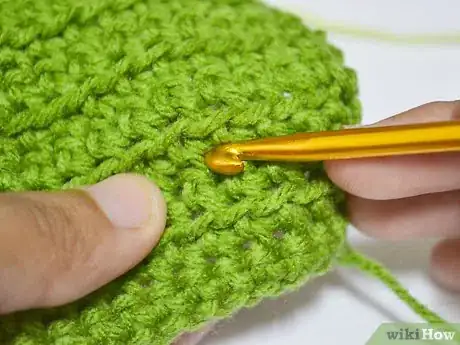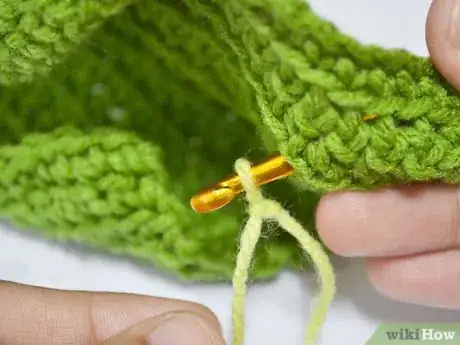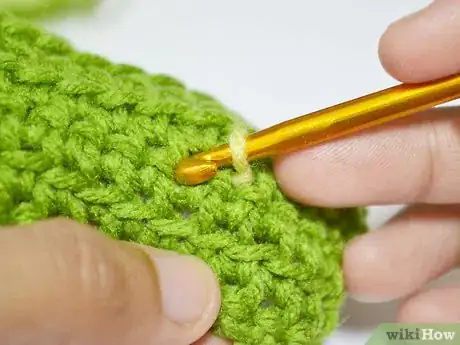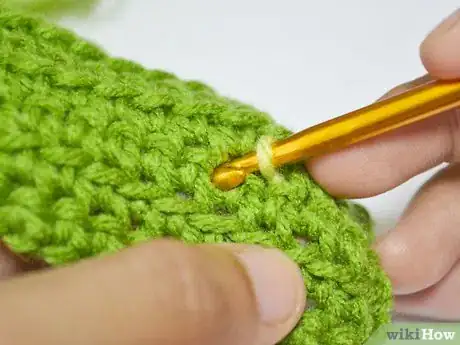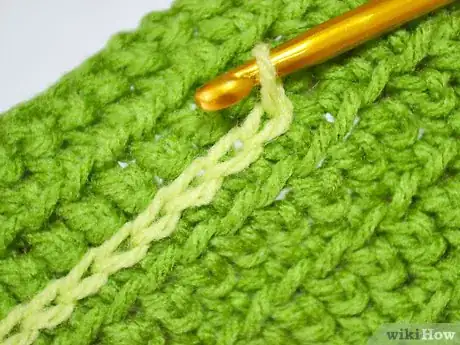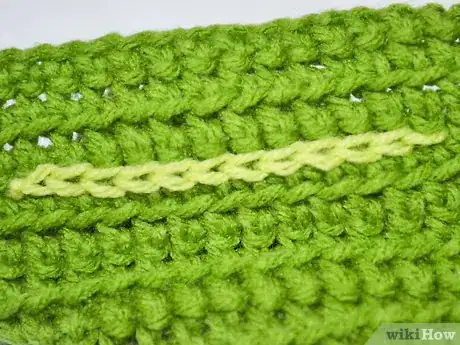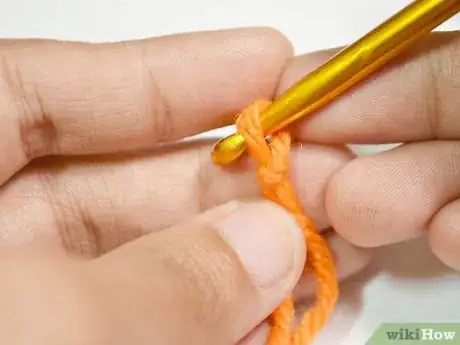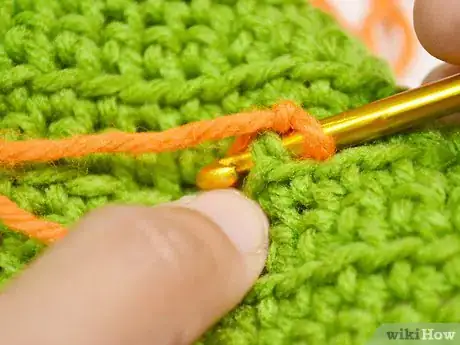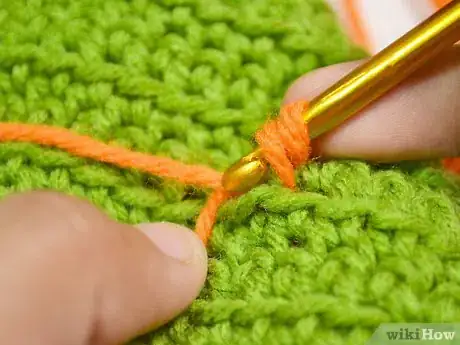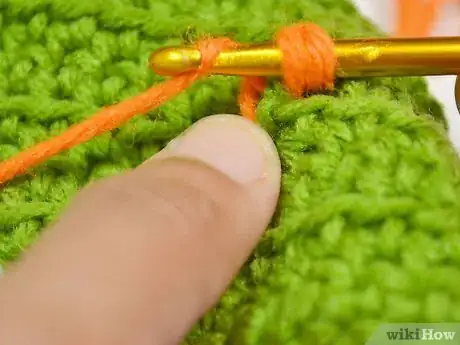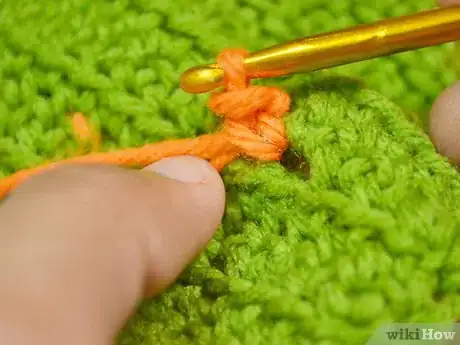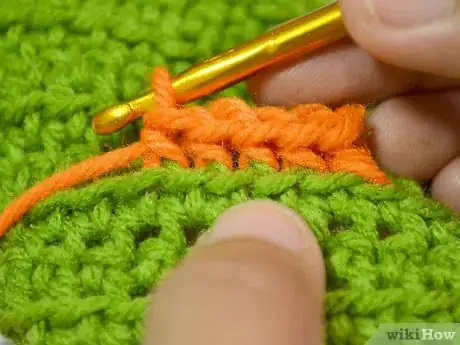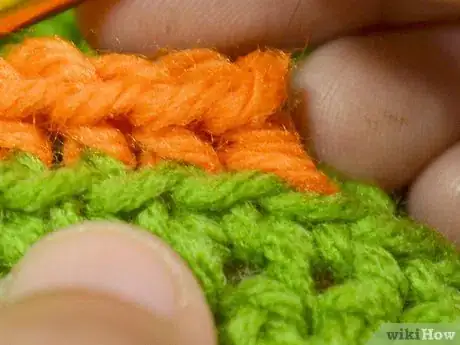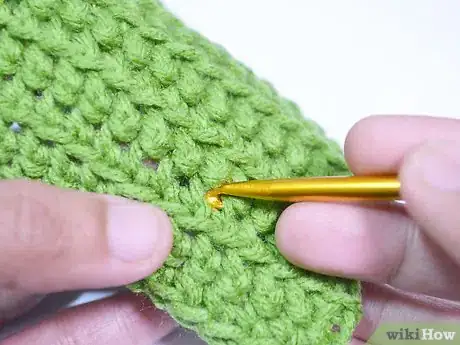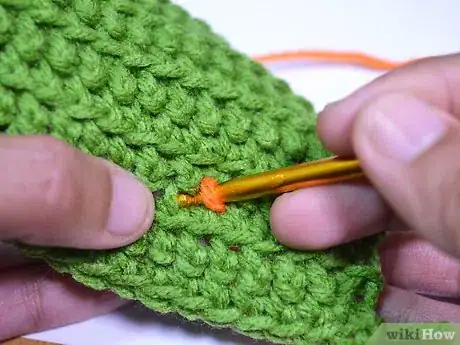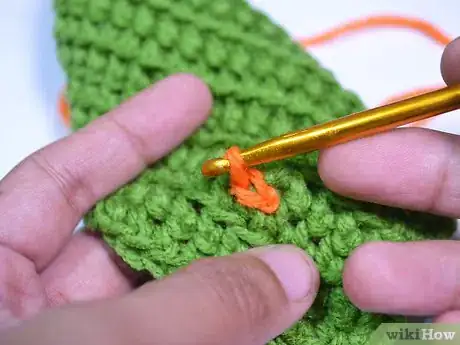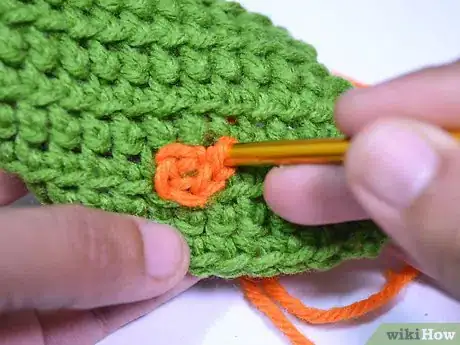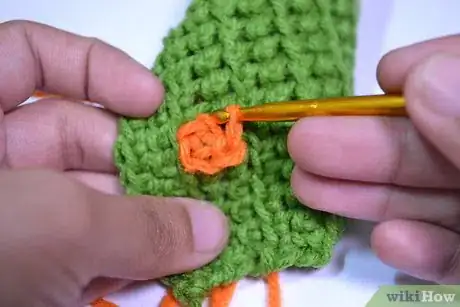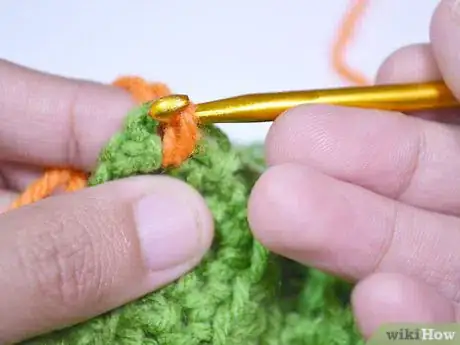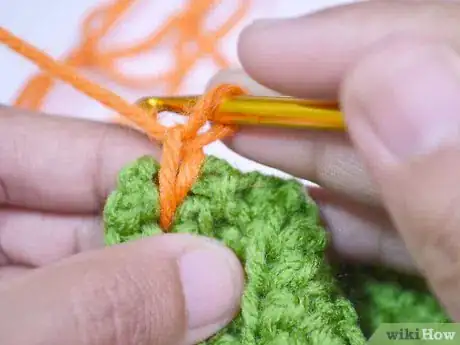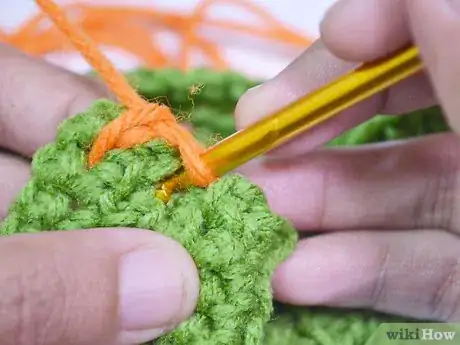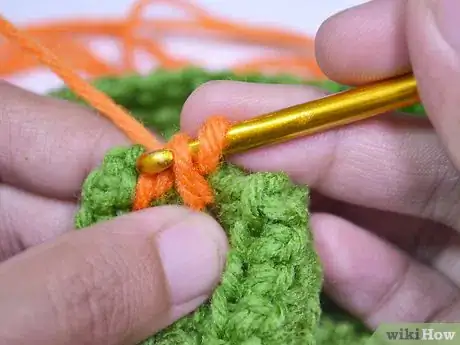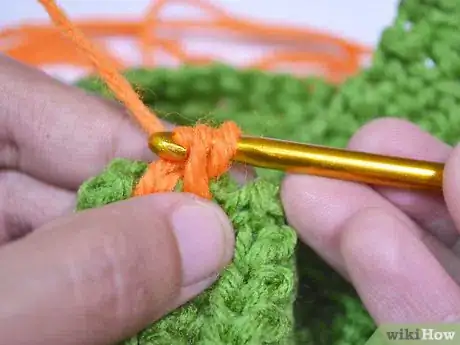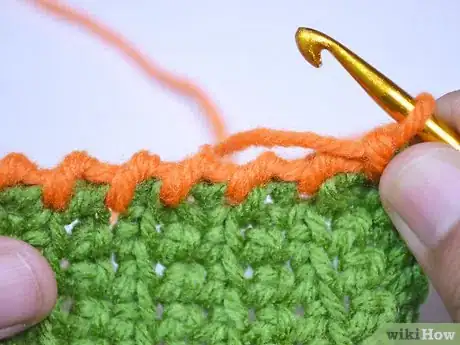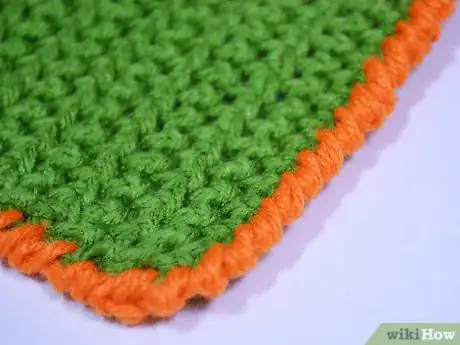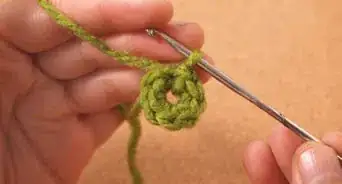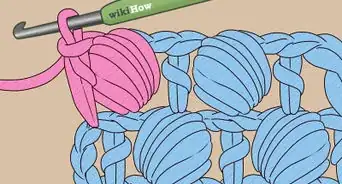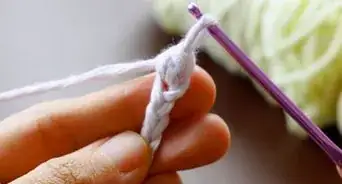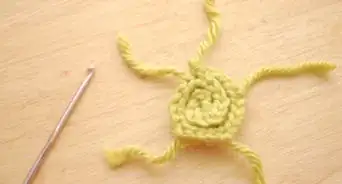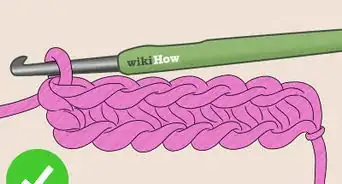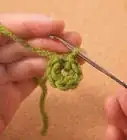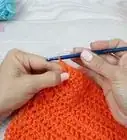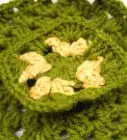wikiHow is a “wiki,” similar to Wikipedia, which means that many of our articles are co-written by multiple authors. To create this article, volunteer authors worked to edit and improve it over time.
wikiHow marks an article as reader-approved once it receives enough positive feedback. In this case, 93% of readers who voted found the article helpful, earning it our reader-approved status.
This article has been viewed 72,798 times.
Learn more...
Surface crochet refers to any crochet technique used to decorate the surface of a previously crocheted work. The surface slip stitch is one of the easiest, most basic skills to master, but once you get used to surface crochet in general, you can also try a few other techniques.
Steps
Method One: Surface Slip Stitch[1]
-
1Insert the hook into the first stitch. Slide the tip of the hook into the spot where your surface design needs to start.
- Insert the hook from the front of your work to the back of it.
-
2Tie the yarn onto the hook. Attach the yarn to the tip of the hook using a slip knot.
- This slipknot must lie behind your work.
- Note that you can skip the slipknot step, but using a slipknot adds security to the beginning stitch, so it is highly recommended.
Advertisement -
3Pull up a loop. Bring the hook back through to the front of your work. The loop of the slipknot should be at the front of the work.
- Both the tail and working side of the yarn should still be behind the work.
-
4Insert the hook into the next spot. Poke the tip of the hook into the next stitch, space, or row.
- The right spot will depend on your design. If your design runs with the original stitches, you will need to insert the hook into the next stitch or space of the same row. If your design runs against your original stitches, you will need to insert the hook into the corresponding stitch or space of the adjacent row.
-
5Yarn over. Wrap the yarn around the tip of your hook from behind your work.
-
6Pull up the loop. Bring the hook and yarn-over back through to the front of your work, drawing up a loop in the process.
- There should be two loops on your hook when you finish this step.
-
7Pull the second loop through the first. Use the hooked portion of the hook to drag the top loop through the bottom loop.
- Doing this should leave you with only one loop on your hook.
- This completes one surface slip stitch.
-
8Repeat as needed. Make additional slip stitches across the original work as needed to complete the desired design.
- Note that surface slip stitches can be used to create single line designs, parallel lines, and free-form shapes.
-
9Bind off the yarn. When you reach the end of your design, cut the yarn from behind the work, leaving a tail roughly 4 inches (10 cm) long. Pull this tail through the loop on your hook, still working along the back of the piece, to secure your surface slip stitches.
- Weave the loose tail in along the back of your work.
- This step completes the process and removes the last loop from your hook.
Method Two: Surface Single Crochet
-
1Attach the yarn to the hook. Use a slip knot to tie the yarn onto the crochet hook.
-
2Insert the hook through the first stitch. Slide the hook into the first stitch you plan to work with for your design.
- More specifically, insert the hook through the back horizontal bar of the stitch you're working over.
- If you're familiar with standard single crochet, this back horizontal bar will be treated as the top portion of the stitch you'd usually work with.
-
3Pull up a loop. Yarn over the tip of the hook from back to front while the hook is still behind the overall piece. Pull the hook and this yarn-over back to the front of the piece, creating a loop in the process.
- There should be two loops on your hook after this step.
-
4Yarn over the hook. Wrap the yarn over the tip of the hook again, working from back to front.
-
5Pull the yarn through. Grab the previous yarn-over with the hooked tip and carefully pull it through both loops on the hook.
- This completes one surface single crochet.
- Note that there should be one loop left on your hook when you complete the stitch.
-
6Repeat as needed. Work as many single surface crochet stitches as needed to complete the desired surface pattern.
- You will essentially be working a row of standard single crochet. Instead of inserting the hook through the next stitch in the row, though, you'll be inserting the hook through the next stitch of the piece you're decorating.
-
7Fasten off the yarn. When you reach the end of the pattern, cut the yarn, leaving a 4-inch (10-cm) tail. Grab this tail with your crochet hook and pull it through the final loop on your hook.
- This should get rid of the last loop on your hook and tie off your project.
- Note that you should also weave in the loose tail end to hide it and help prevent the stitches from unraveling.
Method Three: Crochet Dot[2]
-
1Insert the hook. Insert the hook through the first stitch or space to be worked over.
- The hook should not be attached to any yarn yet.
- Note that the right side of the piece should face toward you but the yarn should be at the back.
-
2Draw up a loop. Grab the yarn with your hook. Pull both the yarn and hook through to the front of the piece.
- You should have one loop on your hook after completing this step.
-
3Insert the hook into the next stitch. Insert the hook into the stitch or space directly next to the one you first worked in.
-
4Chain one through the stitch. Yarn over the hook from back to front. In one motion, pull the yarn-over back through to the front of the work while also pulling it through the loop previously on your hook.
- If this motion is too difficult for you to master, you can pull the yarn-over through to the front of the work first before pulling it through the loop on your hook.
- You've essentially just completed one chain stitch over the surface of the original piece, thereby securing the yarn in place.
-
5Repeat several times. Insert the hook back into the second worked stitch and follow the same procedure to create another chain stitch. Repeat this as many times as needed to build the size dot you desire.
- For a moderately sized dot, create three to five of these stitches.
- Each of these chain stitches must be worked over the same stitch of your original piece.
-
6Insert the hook into the next stitch. When you're satisfied with the dot size, insert the hook through the stitch or space directly next to the one your chain stitches were worked into.
-
7Chain one. Yarn over the hook from back to front, then pull this yarn-over back through to the front of the work while simultaneously pulling it through the loop already on your hook.
- As before, you can pull the yarn-over through to the front of the work before pulling it through the loop if doing so is easier for you.
- This final chain stitch closes the dot.
-
8Fasten off the yarn. Cut the yarn, leaving a 4-inch (10-cm) tail. Pull this tail through the loop on your hook to finish and secure the stitch.
- Pull the loose tail of yarn back through to the back of the work and weave it into the underside of the piece to hide it. This step also provides the dot with further security.
Method Four: Surface Crab Stitch[3]
-
1Insert the hook. Insert the hook into the first stitch you plan to work over.
- The right side of the work should face up and the yarn should be behind the original piece.
- There should be no yarn on the hook at this time.
-
2Attach the yarn to the hook. Tie the yarn onto the hook using a slip knot.
- The slipknot should be positioned near the tip of the hook and at the back of the original piece.
-
3Chain one. Yarn over the hook from back to front, then pull that yarn-over through the loop on your hook to complete one chain stitch.
- At the same time or immediately after completing the stitch, bring the hook and the yarn on your hook back through to the front of the original piece.
-
4Insert the hook into the reverse next stitch. Insert the tip of the hook into the stitch behind your first stitch, working in the opposite direction you would usually work in.
- If you're right-handed, you will need to insert the hook into the next stitch to the right.
- If you're left-handed, you will need to insert the hook into the next stitch to the left.
- This step begins your first official crab stitch.
-
5Draw up a loop. Yarn over the tip of the hook from back to front, then pull the yarn-over back through to the front of the work, creating a loop in the process.
- There should be two loops on your hook after this step.
-
6Yarn over and draw through. Wrap the yarn over the hook from back to front, then pull this yarn-over through both loops on your hook.
- This step completes one crab stitch. Note that another name for this stitch is the "reverse single crochet."
-
7Repeat the crab stitch as needed. Repeat the crab stitch across the original work until you have completed your desired edging or design.
- To complete each crab stitch:
- Insert the hook into the reverse next stitch.
- Yarn over, then draw up a loop to the front of the work.
- Yarn over, then draw it through both loops on your hook.
- Work in the same direction for the entire line of crab stitches. When completed correctly, you should be left with a ridged line.
- To complete each crab stitch:
-
8Fasten off. Cut the yarn, leaving a 4-inch (10-cm) tail. Pull this tail through the final loop on your hook to fasten off your surface stitching.
- Pull the excess tail of yarn through to the back of the work and weave it into the stitches along the back. This further secures the line of crab stitches while also hiding the tail.
Community Q&A
-
QuestionThe title says the instructions are for surface crab stitch, but the picture shows an edging. Does it work the same way for both?
 MicheleTop AnswererThe crab stitch is basically a reverse single crochet. Method four is meant for edgings where you want to minimize stretch. It's called a "surface crab stitch" since it's created on the surface edge of another piece, though most of us just refer to it as the "crab stitch." I had a beautiful knit sweater, but the neck used to stretch out way too much. I added the crab stitch to the edge and voila, no more stretching.
MicheleTop AnswererThe crab stitch is basically a reverse single crochet. Method four is meant for edgings where you want to minimize stretch. It's called a "surface crab stitch" since it's created on the surface edge of another piece, though most of us just refer to it as the "crab stitch." I had a beautiful knit sweater, but the neck used to stretch out way too much. I added the crab stitch to the edge and voila, no more stretching.
Things You'll Need
- Crocheted fabric
- Yarn
- Crochet hook
- Scissors
